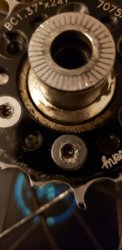The trouble with such kinda bolt heads is that the insertion space for the tool is too small for the head of the bolt, ideally, a tool should have the maximum torque that the size of the bolt head allows.
So the goal is to give the tool more torque on the bolt head itself, meaning creating tool insertion places near the circumference of the bolt, as to achieve the max torque.
You could use a chisel to stamp (holding it straight on 90°) groves near the circumference. Then the chisel under an angle towards the losening direction. First apply penetrating oil, give it some time, and cause vibrations (hammer) / shocks. If the chisel starts to slip, create another grove and start again there.
A better method to start losening something is to first try all the bolts, just enough to see if they move, if they move, fasten them again. If you do find one that doesn't move, start with that one before all others.
If you do all the easy ones first then the mount can tilt abit, causing the remaining / harder bolts to get even harder to lose.
I also wonder why they used countersunk bolt heads at all, the cog shows 17t and it's only below 16 that bolts can start to void the space that the chain needs.



